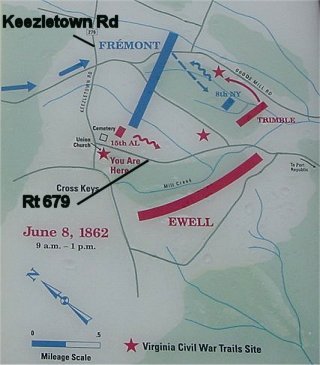
Cross Keys
June 8, 1862
Early on the morning of June 8, 1862, Shields' advance cavalry raided the town of Port Republic, nearly capturing Jackson and the vital Confederate wagon trains. To the north, Jackson had sent forward the 5,800 man Confederate division under Richard Ewell, a chivalrous eccentric atheist bachelor desperately in love with the widowed mother of his staff officer, Campbell Brown. (Not to be confused with the modern leggy news babe.) Ewell was preparing to face the approaching 10,500 man force under one of Lincoln's incompetent political generals, John C. Fremont, the nation's first Republican Presidential candidate.

Cross Keys
Sadly, this is all that remains of the Cross Keys tavern which gives its name to the small community and to the battle. The symbol of crossed keys represents hospitality.

15th Alabama at Union Church Cemetery
|
Ewell placed his division along a wooded ridgeline with artillery at the right-center. The 15th Alabama was sent forward along the Keezletown Road, beyond the Union Church, to contest the Yankee advance and to give Ewell more time to deploy. Fremont could have easily flanked the position to the west and put Ewell in a difficult situation, but instead marched east down White Oak Ridge to the Keezletown Road. There, they began to deploy on the hills in front of the church to face Ewell's strong position. Fremont planned on striking Ewell's eastern, or right, flank. So that morning, Yankees advancing south on the Keezletown Road pushed the 15th Alabama back to the church cemetery, and the rebels contemplated making a stand there. As the enemy approached, however, the regiment withdrew. It would pass in front of the Confederate line and rejoin Trimble's brigade on the far right flank, where it would continue to figure heavily in the action..
|
 |

Union Artillery Near Union Church
This is the view from the other side of Union Church, with the cemetery on the far left, and the Keezletown Road heading south on the right. To the east of the Keezletown Road, Ewell had taken up a position on the wooded ridge with his left not quite reaching the road. Had Fremont attacked in this area, he almost certainly would have pushed Ewell off his formidable position. Instead, while other trrops moved off toward Ewell's right, many of Fremont's men moved across the ground here, near Rt 679, to probe Ewell's center. Artillery was put into a line roughly parallel to this road and dueled their Confederate opponents.
Although clouds obscure it in this photo, and in the previous picture, the Massanutten, which divided Fremont from Shields, would normally be visible on the left of the picture.

Ridgeline
A force under Milroy in Fremont's center probed the Confederates on the ridge, pushing back skirmishers near here and advancing somewhat on the ridge. Other than a prolonged artillery duel, this was the only major action along the center and left of Ewell's position. The main Union effort would be on their left, against the brigade of Isaac Trimble on the Confederate right. Despite being over 60 years old, Trimble was fiery and aggressive .
Back to Cross Keys and Port Republic